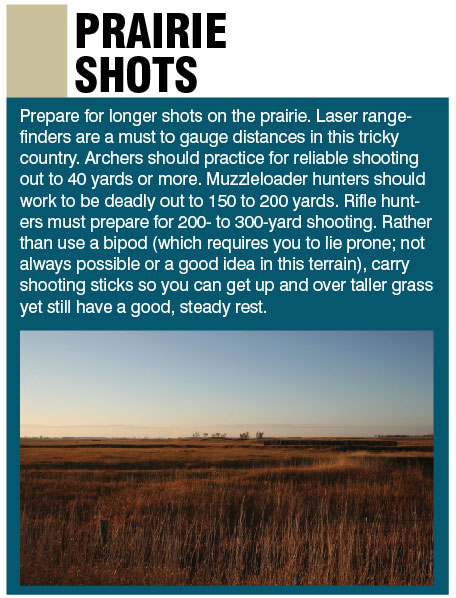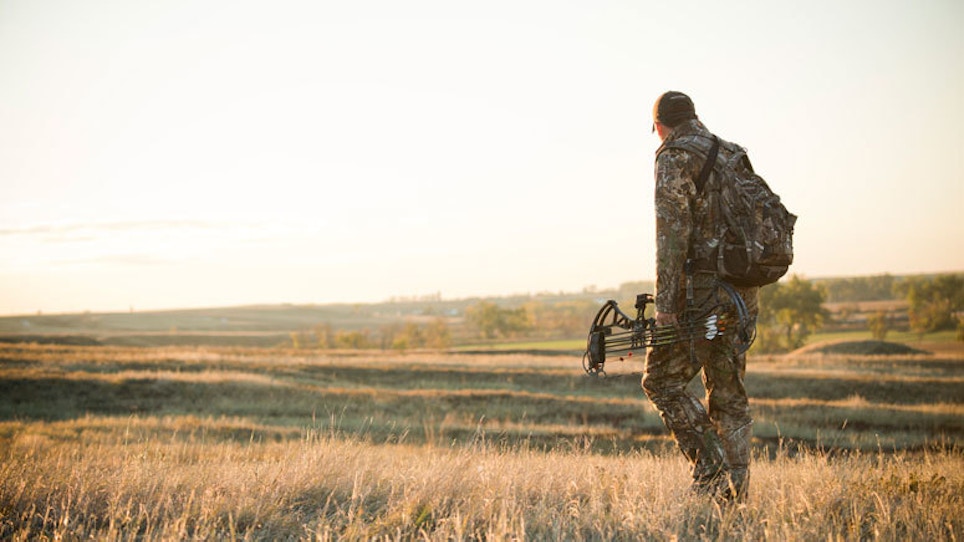Where I grew up and first learned to hunt whitetails in the rolling dairy farm country of southwestern Wisconsin, whitetails and trees went together like Boone and Crockett, Pope and Young, brats and sauerkraut. Interspersed among the crop fields and cow pastures, it was the dense woodlots, sidehill forests and riverbottom timber that held the prime whitetail coverts. Or so we thought.
Sure, we found deer in brushy cover more suited to rabbits, the occasional marsh, and abandoned fields and pastures filled with goldenrod, milkweed, foxtail, thistle and even some native bluestem. But we always figured that was by accident, a result of hunting pressure pushing the whitetails out of their preferred hiding spots in the woods.
When life brought me further west, toward the big wide-open of western Minnesota and the Dakotas, my eyes opened as wide as the horizon. Whitetails lived — and thrived — out there where trees were scarce. Pheasant and duck hunts proved it — whitetail tracks, droppings and plenty of deer sightings.
Soon I was hunting deer out there, too, where the wind always seemed to blow, eyes (of both hunter and hunted) can see forever, and the whitetails appear and vanish like ghosts among both subtle and not-so-subtle terrain features.
The prairie offers any whitetail hunter new challenges, opportunities at bruiser bucks, and rewards to help fill your lifetime’s book of outdoor memories.
Prairie Challenges
Whitetails are hard enough to hunt in any habitat. Add in the wide open vistas of the prairie, along with active and erratic winds, and whitetail eyes and noses become even more formidable defense mechanisms for hunters to defeat.
If you think a little movement can give you away when you’re sitting in the woods, imagine what too much motion can do where the sightlines are so long. There are two good solutions for this challenge.
First, see whitetails before they see you. Good optics are an absolute must for the prairie hunter. Your unaided eye just can’t pick out the detail it needs to consistently find whitetails at long ranges. Arm yourself with the best and brightest 10X binoculars you can afford. You’ll spend a lot of time behind that glass, so don’t skimp on quality. Do learn effective techniques for steadying glass, like planting your index fingers alongside your forehead and supporting the glasses with your thumbs extended below in an L shape. Make glassing a primary part of every prairie hunt, whether you’re trying to spot a buck for a stalk, or you’re waiting on stand in the rare tree or in a ground blind. Either way, seeing a whitetail first is essential.
Second, never skyline yourself on the prairie. It’s too easy to think all that open country is devoid of deer and get lazy in your movements. Whether you’re heading to a stand in daylight, or stalking or still-hunting, it always pays to sneak and skulk on the prairie. Keep to dips, folds, sidehills and other terrain features as you move. Never walk a hilltop or ridgeline. Instead of barging up to take a look into the next drainage, sneak up and look slowly. Only raise your head to peak bit by bit as you slowly “scroll” the next drainage into view.
That covers whitetail eyes. But what about their noses? Whitetails trust their sense of smell without confirmation from any other senses, including their sharp but sometimes disbelieving eyes.
One good thing — the prairie wind is almost always there. You can read it, analyze it and plan your hunt accordingly. One bad thing — prairie breezes are fickle. Be ready to change your hunt plans, whether you’re sneaking-and-peaking a drainage or stalking a particular deer. The prairie hunter must be willing to swing around, loop ahead, backtrack … walk the miles and do what’s needed to keep the wind in his favor.
Sometimes there’s an even bigger challenge than beating prairie whitetail eyes and noses. Sometimes, just finding a deer at all in an ocean of grassland, wetlands, breaks and buttes, pastures, crop fields and other habitat features is a laborious process. The deer are there, but the country is big. An old rancher from southeastern Montana’s sprawling Carter County once put this in perspective for me when he said: “Those dang whitetails are around. But there’s lot of space between ’em.”
Whether you’re trying to spot a whitetail to stalk, make a little push and get a deer up and moving and into a partner’s sights, find a good place to hang a stand in a treeline or grove, or set up a ground blind, it’s essential to understand prairie whitetail bedding strategies.
 On the open prairie and pasture land, and in sprawling fields of Conservation Reserve Program (CRP) fields, whitetails like to bed somewhere with a view. This usually means just below the crest of a knoll, rise or other elevation. Here the whitetail puts the wind at his back so he can use his nose to smell what’s coming from that direction, and uses his eyes to watch the downwind direction for approaching danger. Either way, it’s a quick escape up and over the top if the eyes reveal a problem, or downwind across the wide-open spaces at the first molecule’s whiff of danger from behind.
On the open prairie and pasture land, and in sprawling fields of Conservation Reserve Program (CRP) fields, whitetails like to bed somewhere with a view. This usually means just below the crest of a knoll, rise or other elevation. Here the whitetail puts the wind at his back so he can use his nose to smell what’s coming from that direction, and uses his eyes to watch the downwind direction for approaching danger. Either way, it’s a quick escape up and over the top if the eyes reveal a problem, or downwind across the wide-open spaces at the first molecule’s whiff of danger from behind.
The farther west you go (the western Dakotas, Nebraska, Kansas and eastern Montana and Colorado all come to mind), the more water comes into play for finding prairie whitetails. They might be right in the extra cover of a creek or river bottom. Or they might be in the general vicinity of a stock tank (dugout catch-basin pond for watering cattle) or other watering hole.
Speaking of water, much open-country whitetail hunting is done in prairie pothole country like eastern Dakotas and western Minnesota. Wetlands or marshes, called sloughs out here, abound. Finding whitetails here is not rocket science. They dive in and bed under the cattails and marsh grass, an almost impenetrable jungle. Getting them out or waiting them out are both hard work.
Don’t overlook abandoned farmsteads and their tiny woodlots. While this is obvious cover, whitetails like it here if they are not pressured. Sneak and glass the place from a distance before barging in to check it out.
Finally, don’t be afraid to glass places that offer practically no cover at all. Two seasons ago, I spent six frustrating hours watching a buck and doe bedded smack dab in the middle of a 1-square-mile field of corn stubble in western Minnesota. If they would have only moved, I could have made my own move. It was the rut, but that big old doe knew that nothing could get at her and her suitor out there. Dark finally descended, and that was that.
Every prairie hunt is different. Freelancing and having fun is good. Flex your approach — some sneak-and-peak, some spot-and-stalk, some push-and-post, some sit-and-wait — according to conditions and time of day. Using that grab bag of approaches, while understanding the challenges of prairie whitetail hunting, is the best path to success.
Some hunters come to the prairie to try for the buck of a lifetime. To be sure, there’s the chance for that here. But what you’re guaranteed is memories that will last forever, made out where whitetails roam, where the sky never ends, where the grasslands, sloughs, pastures and crop fields stretch beyond the horizon, and where you can feel about as free as a hunter ever could.






